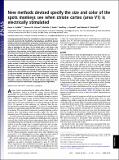New methods devised specify the size and color of the spots monkeys see when striate cortex (area V1) is electrically stimulated
Author(s)
Schiller, Peter H.; Slocum, Warren M.; Kwak, Michelle; Kendall, Geoffrey L.; Tehovnik, Edward J.
DownloadSchiller-2011-New methods devised.pdf (749.0Kb)
PUBLISHER_POLICY
Publisher Policy
Article is made available in accordance with the publisher's policy and may be subject to US copyright law. Please refer to the publisher's site for terms of use.
Terms of use
Metadata
Show full item recordAbstract
Creating a prosthetic device for the blind is a central future task. Our research examines the feasibility of producing a prosthetic device based on electrical stimulation of primary visual cortex (area V1), an area that remains intact for many years after loss of vision attributable to damage to the eyes. As an initial step in this effort, we believe that the research should be carried out in animals, as it has been in the creation of the highly successful cochlear implant. We chose the rhesus monkey, whose visual system is similar to that of man. We trained monkeys on two tasks to assess the size, contrast, and color of the percepts created when single sites in area V1 are stimulated through microelectrodes. Here, we report that electrical stimulation within the central 5° of the visual field representation creates a small spot that is between 9 and 26 min of arc in diameter and has a contrast ranging between 2.6% and 10%. The dot generated by the stimulation in the majority of cases was darker than the background viewed by the animal and was composed of a variety of low-contrast colors. These findings can be used as inputs to models of electrical stimulation in area V1. On the basis of these findings, we derive what kinds of images would be expected when implanted arrays of electrodes are stimulated through a camera attached to the head whose images are converted into electrical stimulation using appropriate algorithms.
Date issued
2011-10Department
Massachusetts Institute of Technology. Department of Brain and Cognitive Sciences; McGovern Institute for Brain Research at MIT; Picower Institute for Learning and MemoryJournal
Proceedings of the National Academy of Sciences
Publisher
National Academy of Sciences
ISSN
0027-8424
1091-6490